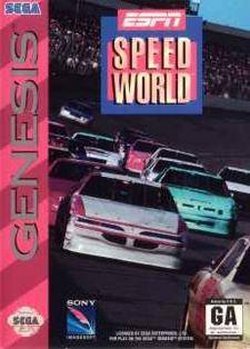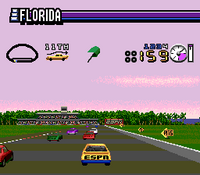Software:ESPN SpeedWorld (video game)
| ESPN SpeedWorld | |
|---|---|
 Sega Genesis cover art | |
| Developer(s) | Park Place Productions[1] |
| Publisher(s) | Sony Imagesoft[2] |
| Designer(s) | Vincent Weeks Phillip Weeks Bob Gordon Mark Lyons Christopher Whaley |
| Platform(s) | Super NES Sega Genesis |
| Release | Sega Genesis: |
| Genre(s) | Racing[3] |
| Mode(s) | Single-player Multiplayer (up to two players) Composition : Rex Baca and Joe Hight |
ESPN SpeedWorld is a Super NES and Sega Genesis video game that was released in 1994 exclusively for North America based on the television series of the same name. The title screen of the video game was partially inspired by the 1993 running of the First Union 400 racing event; which occurred on April 18, 1993. The real-life drivers from the mid-1990s are missing because the game only has an ESPN license and not an official NASCAR license.[4]
Gameplay
Players control NASCAR Winston Cup stock cars as they do laps around various oval tracks, road courses, and superspeedways that are based on the actual NASCAR circuits of the 1990s. All the stock cars in the game have the capability to go up to 200 miles per hour (approximately 322 kilometers per hour). The object of the game is to get as close to first place as possible. This game uses Dr. Jerry Punch[4] and an interactive pit crew to simulate the feeling of racing during the 1993 Winston Cup season. Like most racing games, being in the top positions gives the player more points than being in the bottom positions. Stock cars can be customized with a choice of colors and styles.
Reception
Reviewing the Super NES version, GamePro described the game as "fast, smart, and flat-out fun", praising the inclusion of elements from the TV show, the customization options, and the impressive graphics.[5] Their review of the Genesis version described it as "virtually identical" to the Super NES version.[6]
References
- ↑ 1.0 1.1 "Release information (Sega Genesis version)". GameFAQs. http://www.gamefaqs.com/console/genesis/data/586163.html.
- ↑ "Publisher information". GameSpot. http://www.gamespot.com/genesis/driving/espnspeedworld/index.html.
- ↑ "Genre information". IGN. http://cheats.ign.com/objects/011/011196.html.
- ↑ 4.0 4.1 "Advanced game overview". MobyGames. http://www.mobygames.com/game/espn-speed-world.
- ↑ "Speed World Gets the Win". GamePro (IDG) (65): 194. December 1994.
- ↑ "Speed World Races Strong". GamePro (IDG) (67): 114. February 1995.
 |


